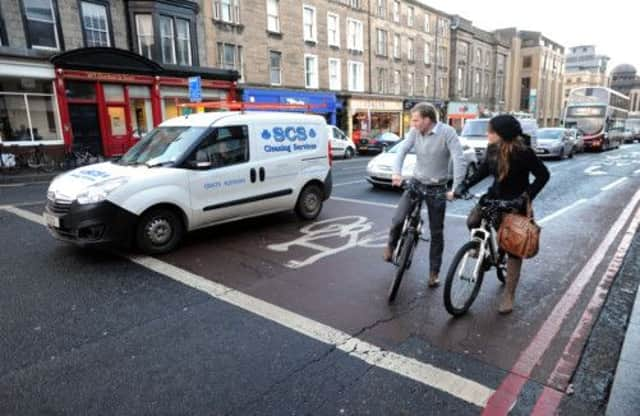Drivers face £100 fines for invading cyclist space


The “safe zones” at junctions, usually painted red or green, are designed to make cyclists more visible to other traffic and give them priority at red lights. However, some motorists ignore them or fail to see them.
Police Scotland stressed it will be equally targeting law-breaking cyclists, such as those who ride through red lights, on pavements or ignore no entry signs, who also face £100 fines.
Advertisement
Hide AdAdvertisement
Hide AdThe get-tough approach follows a “softly, softly” education campaign in the city centre last week, when nearly 200 errant drivers and cyclists were let off with warnings.
• Have you spotted drivers stopping in cyclist spaces? Send in your pictures for our gallery >>
The force said the initiative might be repeated elsewhere in the country after the end of the current campaign tomorrow.
The move was backed by motoring groups, but cycle campaigners are divided over whether the zones are a safety benefit or danger.
Constable Stephen Kirk, of Police Scotland, said: “The first week of the initiative was aimed at educating road users whose behaviour on city centre roads warranted intervention.
“This week we will be focusing more heavily on enforcement and taking tough action against anyone we identify as repeat or blatant offenders.
“The ultimate aim of the initiative is to reduce road casualties in the city centre at a time of year where casualty numbers rise, particularly among cyclists.”
Dave du Feu, of Spokes, the Lothian cycle campaign, said: “Advanced stop zones are not the ideal solution, but hugely better than nothing. They give all road users better vision – of everybody, by everybody, and there is evidence of reduced casualties at such junctions.”
Advertisement
Hide AdAdvertisement
Hide AdHowever, Dave Brennan, an organiser of the annual Pedal on Parliament event, when cycle campaigners converge on Holyrood, described advanced stop zones as “the spawn of Satan”. He said: “They are a retrograde step and waste of money, which give cyclists a false sense of security.”
Mr Brennan said cyclists in the zones were not visible from lorry cabs, and they were often in danger trying to reach the zones through queueing traffic.
He said this was particularly hazardous where the “feeder” cycle lane to the zone was narrow because the traffic lights might change while cyclists were still pedalling up the inside of the queue. Mr Brennan called instead for cycle lanes segregated from other traffic at junctions.
Superintendent Iain Murray, head of road policing for Police Scotland, said: “The Edinburgh plan is a local initiative in answer to particular issues that exist in the capital. Where similar concerns exist elsewhere in the country, a variant of the plan might be considered.”
Neil Greig, the Scotland-based policy director of the Institute of Advanced Motorists, said: “The police seem to be going about this in the right way, with an information and warning campaign before they start hitting drivers with fines.
“I have no doubt drivers do sometimes invade advanced stop lines, but it can be inadvertent or through ignorance of their function.”
Automobile Association president Edmund King said: “The police are right to warn drivers and cyclists who aren’t following the rules of the road. A warning or driver/rider improvement courses are preferable to fines and penalty points.”
The City of Edinburgh Council transport vice-convener and cycling leader Jim Orr said: “A lot of work goes into encouraging cyclists to use the centre of Edinburgh, and these areas at traffic lights can make drivers more aware they need to keep distance between them and bikes.”
Advertisement
Hide AdAdvertisement
Hide AdA cyclist’s view: Junctions designed for all road users are the best solution
Dr Sara Dorman
IF YOU talk to drivers about advanced stop zones (ASZs), you get a lot of funny answers.
Many seem honestly unaware that they have just crossed a stop line.
One taxi driver told me it was his belief that they were officially not in use after 7:30pm.
Another driver – hearing my foreign accent – told me to learn the rules of the road. I told him: “It’s rule 178 of the Highway Code if you want to check it out, and I’ve cycled here for nearly 20 years.”
Stopping at a stop line is about the most basic skill a driver needs to have, but it seems to bring out the worst in some people.
Drivers hate cyclists “getting a head start”, while cyclists will desperately try to get to the front of a queue of traffic to get into the perceived haven of the ASZ.
But ASZs aren’t about cyclists getting “ahead”. They are about protecting cyclists from being “left-hooked” by drivers turning while cyclists are travelling straight on.
Advertisement
Hide AdAdvertisement
Hide AdEvery cyclist has had a driver tell them to get “out of the road”. But the gutter on the left is the most dangerous place for a cyclist, especially at junctions.
So, yes, it would be good if drivers stayed out of ASZs, and that police were able to enforce a ban on motorists driving into them when a traffic light is at red.
But ASZs are also a red herring. In reality, they are
not big enough to protect cyclists from HGVs’ blind spots and they can be dangerous to get to.
Painting ASZs on roads is essentially a “tick box”. It means any council that has them can say “look, we’ve taken cyclists into account”.
But if there’s not road space for cyclists to get there, or if there are parking bays on top of the cycle lanes, then the ASZ is basically useless.
The bottom line is, if our road junctions were properly designed for the safety of all users – pedestrians, cyclists, and motorised vehicles – we wouldn’t need ASZs at all.
• Dr Sara Dorman is an Edinburgh cyclist